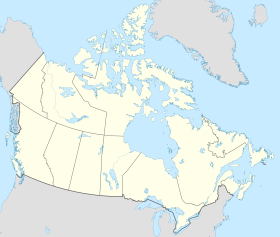Alberta
Alberta | |
|---|---|
| Motto(s): Latin: Fortis et liber ("Strong and free") | |
| Coordinates: 54°59′30″N 114°22′36″W / 54.99167°N 114.37667°W | |
| Country | Canada |
| Confederation | September 1, 1905 (split from Northwest Territories) (8th/9th, with Saskatchewan) |
| Capital | Edmonton |
| Largest city | Calgary |
| Largest metro | Calgary Region |
| Government | |
| • Type | Constitutional monarchy |
| • Lieutenant governor | Salma Lakhani |
| • Premier | Danielle Smith (UCP) |
| Legislature | Legislative Assembly of Alberta |
| Federal representation | Parliament of Canada |
| House seats | 34 of 338 (10.1%) |
| Senate seats | 6 of 105 (5.7%) |
| Area | |
| • Total | 661,848 km2 (255,541 sq mi) |
| • Land | 640,081 km2 (247,137 sq mi) |
| • Water | 19,531 km2 (7,541 sq mi) 3% |
| • Rank | Ranked 6th |
| 6.6% of Canada | |
| Population (2016) | |
| • Total | 4,067,175 [1] |
| • Estimate (2020 Q4) | 4,428,112 [2] |
| • Rank | Ranked 4th |
| • Density | 6.35/km2 (16.4/sq mi) |
| Demonym | Albertan |
| Official languages | English[3][4] |
| GDP | |
| • Rank | 3rd |
| • Total (2015) | CA$326.433 billion[5] |
| • Per capita | CA$78,100 (2nd) |
| HDI | |
| • HDI (2018) | 0.940[6] — Very high (1st) |
| Time zone | UTC−07:00 (Mountain) |
| • Summer (DST) | UTC−06:00 (Mountain DST) |
| Postal abbr. | AB |
| Postal code prefix | |
| ISO 3166 code | CA-AB |
| Flower | Wild rose |
| Tree | Lodgepole pine |
| Bird | Great horned owl |
| Rankings include all provinces and territories | |
Alberta is a province in western Canada. It is bounded by the provinces of British Columbia on the west, Saskatchewan on the east, the US state of Montana on the south and the Northwest Territories to the North.
Alberta is the fourth largest Canadian province with an area of 642,317 square kilometres (248,000 sq mi).[7] Alberta has around 4,067,175 living there, making it the fourth most populous province in Canada.
The capital of Alberta is Edmonton lying near the middle of Alberta. The city of Calgary, Alberta’s other major centre is located about 300 kilometres to the south of Edmonton.
History
[change | change source]Canada became a country in 1867. It was much smaller than it is now, and did not include the parts of the country to the west. From 1670 to 1870, parts of Alberta were included in "Rupert's Land", land owned by the Hudson’s Bay Company in support of its trading monopoly over a vast area of Canada and parts of the United States. Northern part of Alberta was part of the what was then called "Northwestern Territories".
Alberta was made a province of Canada in 1905, at the same time as Saskatchewan.
The Aboriginal peoples of Canada are referred to as First Nations or by the Name of their Nation. Mixed (European/Aboriginal) People are called Metis.
Weather
[change | change source]Alberta is very cold in the winter and has a lot of snow during the very cold season. There is a dry part of Alberta in the south.
Work in Alberta
[change | change source]Alberta has a huge amount of oil (in the Athabasca Oil Sands) and natural gas.
There are also a lot of farms in Alberta. Farmers grow several different types of crops Farmers mainly grow wheat. There are also a lot of cows on Alberta farms, and Alberta beef is exported.
References
[change | change source]- ↑ "Population and dwelling counts, for Canada, provinces and territories, 2016 and 2011 censuses". Statistics Canada. February 2, 2017. Retrieved April 30, 2017.
- ↑ "Population by year of Canada of Canada and territories". Statistics Canada. September 26, 2014. Archived from the original on June 19, 2016. Retrieved September 29, 2018.
- ↑ "Languages Act". Government of Alberta. Archived from the original on May 2, 2021. Retrieved March 7, 2019.
- ↑ Dupuis, Serge (5 February 2020). "Francophones of Alberta (Franco-Albertains)". The Canadian Encyclopedia. Retrieved 30 September 2020.
In 1988, as a reaction to the Supreme Court's Mercure case, Alberta passed the Alberta Languages Act, making English the province's official language and repealing the language rights enjoyed under the North-West Territories Act. However, the Act allowed the use of French in the Legislative Assembly and in court.
- ↑ "Gross domestic product, expenditure-based, by province and territory (2015)". Statistics Canada. November 9, 2016. Retrieved January 26, 2017.
- ↑ "Sub-national HDI - Subnational HDI - Global Data Lab". globaldatalab.org. Retrieved June 18, 2020.
- ↑ There are also two larger parts of Canada called Nunavut and Northwest Territories. However, Nunavut and Northwest Territories are territories, not provinces.
Other websites
[change | change source]| Definitions from Wiktionary | |
| Media from Commons | |
| News stories from Wikinews | |
| Quotations from Wikiquote | |
| Source texts from Wikisource | |
| Textbooks from Wikibooks | |
| Learning resources from Wikiversity | |
- Wikimedia Atlas of Alberta
- Government of Alberta website
- Alberta at the Open Directory Project
- Provincial Archives of Alberta website Archived 2013-02-20 at the Wayback Machine
- Travel Alberta
- Alberta Encyclopedia
- CBC Digital Archives—Striking Oil in Alberta
- CBC Digital Archives—Electing Dynasties: Alberta Campaigns 1935 to 2001
- CBC Digital Archives—Alberta @ 100



